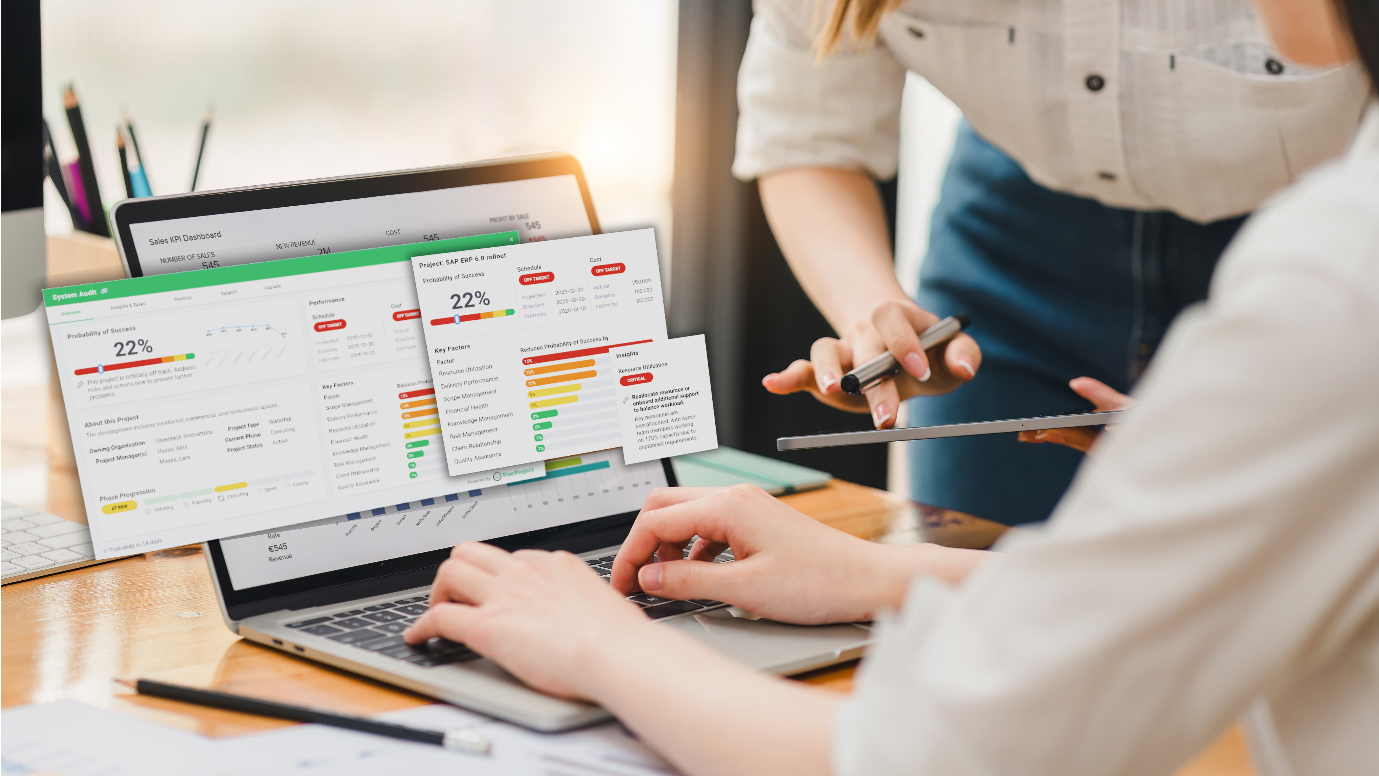
Projects rarely go exactly as planned. Yet, many organizations still treat contingency planning as an afterthought. The result? Cost overruns, delayed timelines, strained teams, and outcomes that fall short of expectations. For decision-makers, the message is clear: a contingency plan isn't a backup strategy; it's an essential part of project execution.
Contingency planning is about proactive choices that protect project goals with data-backed foresight. A well-structured contingency plan ensures that when challenges arise—and they will—your team has a clear, actionable strategy to respond effectively.
This article explores the most common pitfalls of contingency plans, the actual cost of inadequate preparation, and how advanced predictive solutions can transform this process into a strategic advantage.
See Predictive Intelligence in Action: Watch the TrueProject capabilities video to discover how advanced, real-time insights help teams anticipate risks and keep projects on track.
The Five Pitfalls of Project Contingency Plan
Even experienced teams can stumble when contingency plans fall short. These pitfalls often stem from fundamental gaps in risk anticipation, monitoring, and response. Here are five common mistakes that undermine contingency efforts:
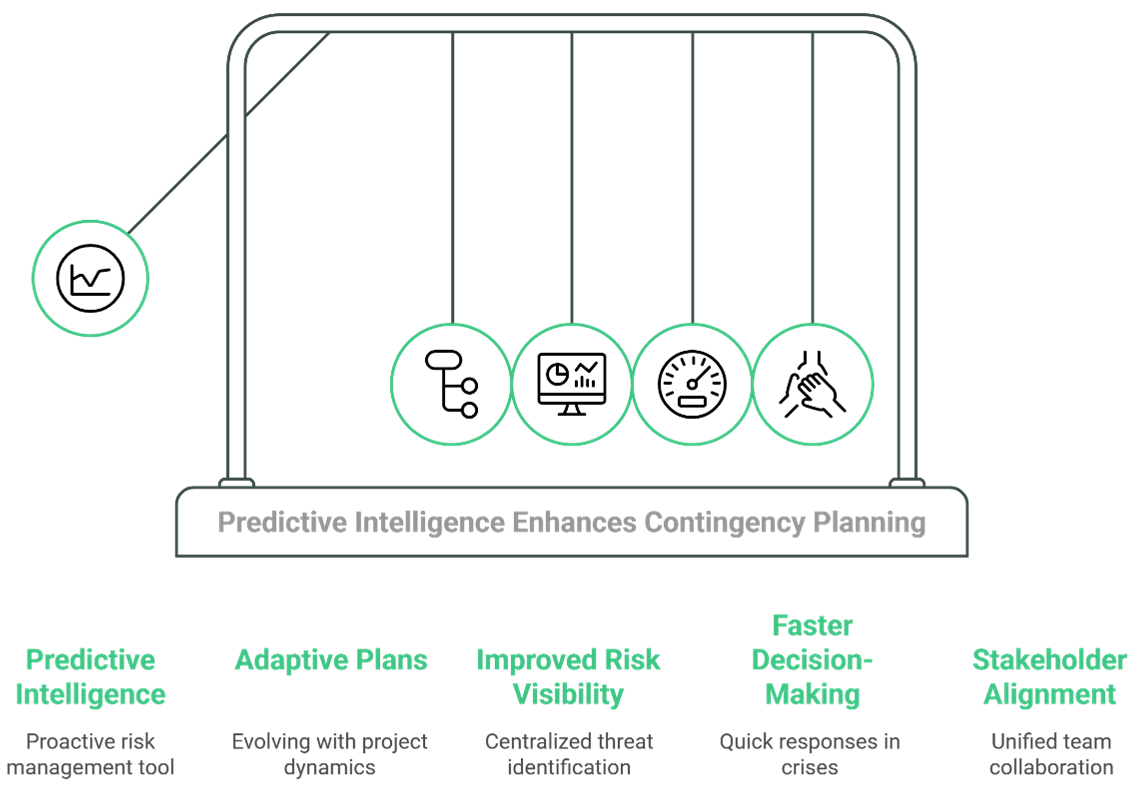
1. Static Plans That Don’t Evolve
Many contingency plans are created early and forgotten. However, projects are dynamic—budgets shift, timelines change, and risks emerge unexpectedly. These plans become irrelevant without continuous updates, leaving teams unprepared when issues surface.
2. Overreliance on Historical Data
While historical data provides context, it can't predict new risks. Rapidly changing technologies, trends, and regulations introduce variables not found in past reports. Relying solely on yesterday's patterns blinds teams to today’s emerging threats.
3. Fragmented Risk Visibility
Critical warning signs slip through the cracks when teams track risks using isolated spreadsheets or disconnected tools. Without centralized visibility, decision-making becomes guesswork, and preventable risks escalate into costly problems.
4. Delayed Decision-Making
Manual data gathering and layered approval processes slow decisions when time matters most. By the time teams agree on a course of action, minor risks can snowball into significant disruptions.
5. Disjointed Stakeholder Collaboration
Contingency plans often break down when teams operate in silos. Misaligned understanding and poor communication lead to inconsistent responses, delays, and costly mistakes.
These pitfalls turn contingency planning into guesswork. To avoid these traps, teams need predictive insights that continuously track project health and provide actionable foresight.
Ready to Mitigate Project Uncertainty Head-On? Schedule a discussion with our experts to learn how TrueProject helps teams avoid these common pitfalls with predictive insights.
Predictive Intelligence: The Missing Piece in Contingency Plan
Traditional contingency plans often rely on assumptions and static forecasts, leaving teams vulnerable to risks that evolve mid-project. Predictive intelligence changes the game by turning real-time data into early warnings and actionable insights.
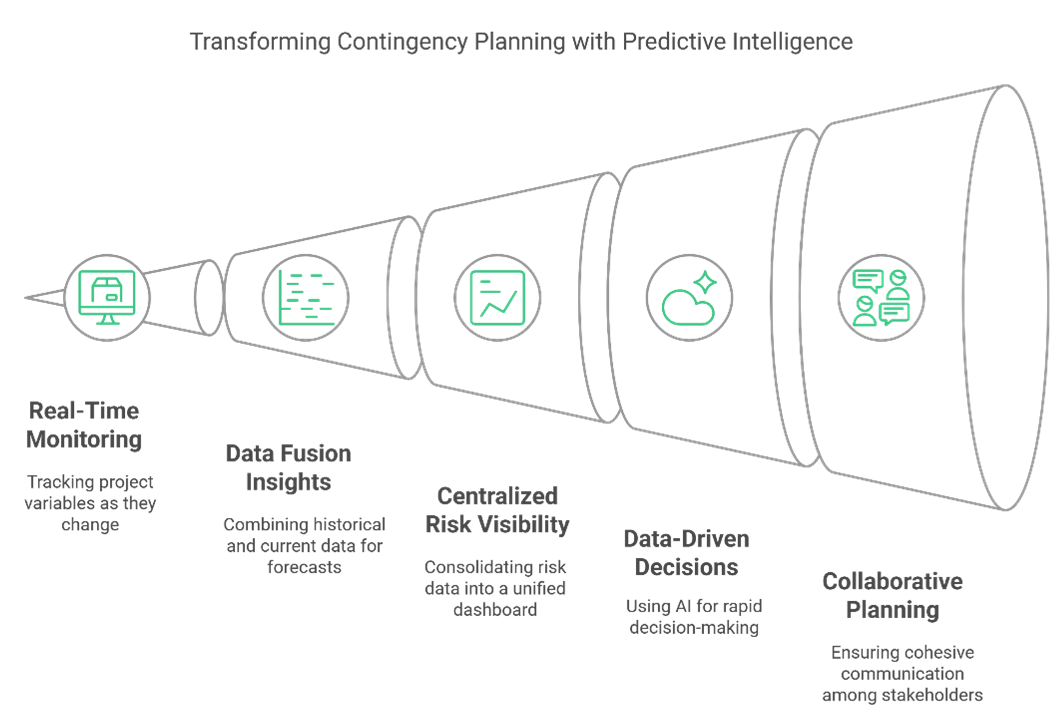
Here’s how predictive capabilities can transform contingency planning from reactive guesswork into a proactive, informed process:
1. Dynamic Risk Monitoring
Predictive solutions track budgets, schedules, and performance indicators in real-time. When deviations occur, teams receive instant alerts to adjust plans before issues escalate.
2. Context-Aware Insights
Historical data alone is insufficient. Advanced tools combine past trends with current metrics to detect anomalies and project potential outcomes, helping teams anticipate unfamiliar risks.
3. Centralized Risk Visibility
When risk data lives in spreadsheets or fragmented systems, patterns go unnoticed. Predictive platforms consolidate all risk information into a unified dashboard for full-spectrum visibility and quicker decision-making.
4. Accelerated Decision Support
AI-driven algorithms analyze project performance and recommend corrective actions. This minimizes delays and ensures decisions are based on real-time data rather than assumptions.
5. Seamless Collaboration
Advanced predictive intelligence eliminates communication gaps by providing shared dashboards. All stakeholders see the same insights, ensuring aligned, consistent responses to emerging risks.
Experience the Future of Contingency Planning: Request a demo and see how TrueProject uses predictive intelligence to keep projects on schedule, within scope, and on budget.
Key Components of an Effective Project Contingency Plan
Most contingency plans fail because they are designed as static documents instead of adaptable, actionable frameworks. Effective contingency planning requires more than listing potential risks; it demands a systematic, predictive approach that evolves alongside the project. Here are the key components that distinguish a contingency plan built for success:
1. Real-Time Risk Identification
Risk identification isn’t a one-time task—it’s a continuous process. Traditional methods rely on outdated reports and guesswork, exposing teams to emerging risks. Real-time risk tracking ensures that performance metrics are monitored constantly, flagging subtle shifts that might indicate trouble ahead.
2. Impact Analysis and Risk Prioritization
Not all risks carry the same weight. An effective contingency plan evaluates the potential impact of each risk on the project’s objectives. By assessing cost, schedule, and operational impact, teams can prioritize the most critical risks and allocate resources accordingly.
3. Scenario-Based Planning
Project environments are inherently unpredictable, making scenario-based planning essential. By modelling potential outcomes under different conditions—such as delays, resource shortages, or scope changes—teams can prepare pre-emptive strategies that allow for quick, confident responses.
4. Integrated Communication Across Teams
Contingency plans can’t succeed if teams work in silos. A well-structured plan integrates communication channels so that risk updates, action steps, and performance metrics are accessible to all relevant stakeholders in real-time.
5. Continuous Monitoring and Adaptive Adjustments
A static contingency plan becomes irrelevant within weeks of a project’s launch. Continuous monitoring ensures the plan remains adaptable, with risk assessments updated based on live project data.
By embedding these components into the planning process, project teams can build dynamic, practical, and responsive contingency plans to real-world challenges. But having the right components isn’t enough—you need the right system to bring them to life. TrueProject provides the intelligence and clarity needed to transform contingency planning into a competitive advantage.
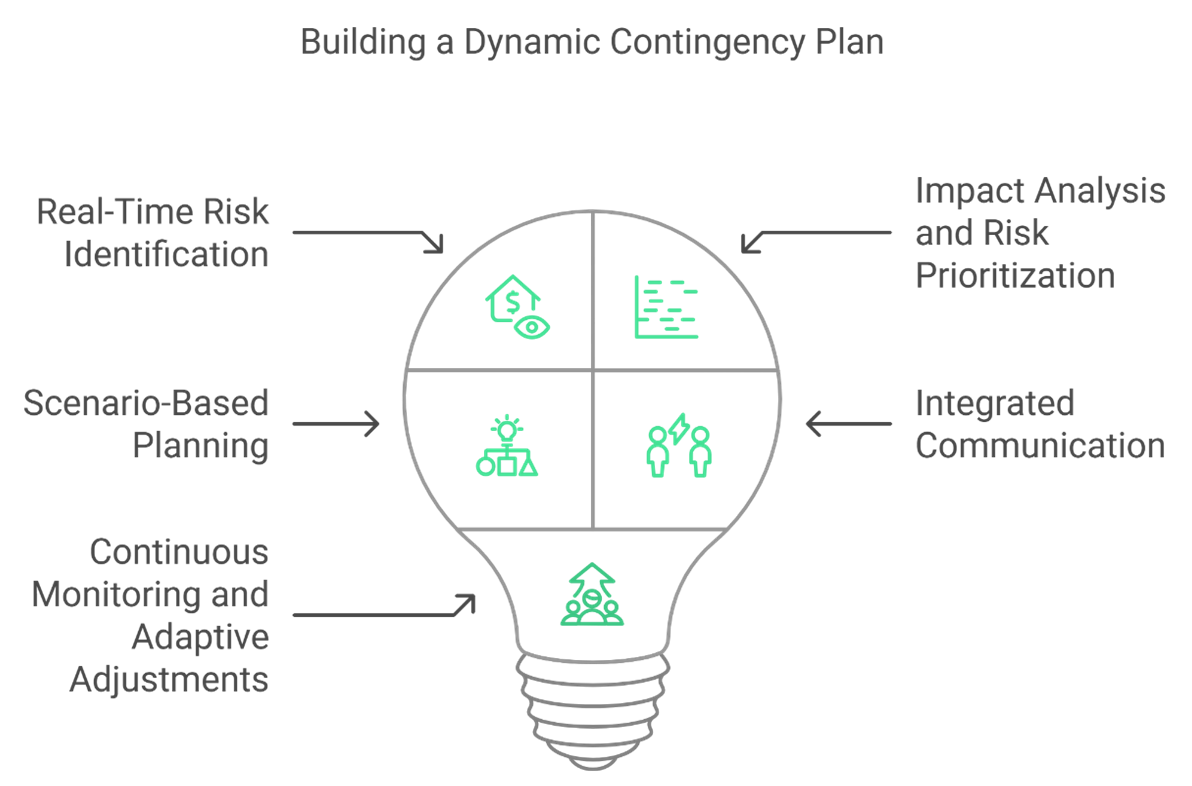
Turning Contingency Plan into a Strategic Advantage
Contingency planning has long been viewed as a defensive strategy—a backup plan to mitigate damage when things go wrong. But this perception is outdated. In reality, effective contingency planning is a strategic enabler that strengthens decision-making, optimizes resource allocation, and enhances overall project performance.
When approached proactively, contingency planning becomes a tool for continuous project improvement, providing insights that help teams anticipate risks and respond with precision. The difference lies in the mindset: instead of preparing for potential failure, teams use contingency planning to drive better outcomes from the start.
So, how does this shift from reactive to proactive planning create a strategic advantage?
1. Improved Resource Allocation
Miscalculated resource allocation doesn't just delay tasks; it disrupts momentum, wastes budgets, and jeopardizes project success. Proactive contingency planning identifies possible resource constraints early, allowing teams to distribute personnel, time, and capital more effectively across project phases.
2. Enhanced Budget Control
Cost overruns remain one of the most common and damaging project risks. Predictive, data-driven contingency planning uses ongoing cost performance metrics to detect budget deviations early, helping teams correct course before minor discrepancies evolve into significant overruns.
3. Streamlined Decision-Making
When risks emerge, decision-making speed becomes critical. Predictive contingency planning addresses this by providing a centralized source of truth, where risks are automatically prioritized based on severity and projected impact.
4. More Accurate Forecasting
Forecasting risks based solely on historical performance data is like driving using only the rearview mirror—it provides context but fails to capture what lies ahead. Proactive contingency planning incorporates predictive analytics that track live project data and model potential risk scenarios.
5. Greater Stakeholder Confidence
Uncertainty breeds doubt. Proactive contingency planning mitigates this by offering transparent, data-backed insights into project health and potential risks. When stakeholders access clear, up-to-date information, confidence in project leadership grows.
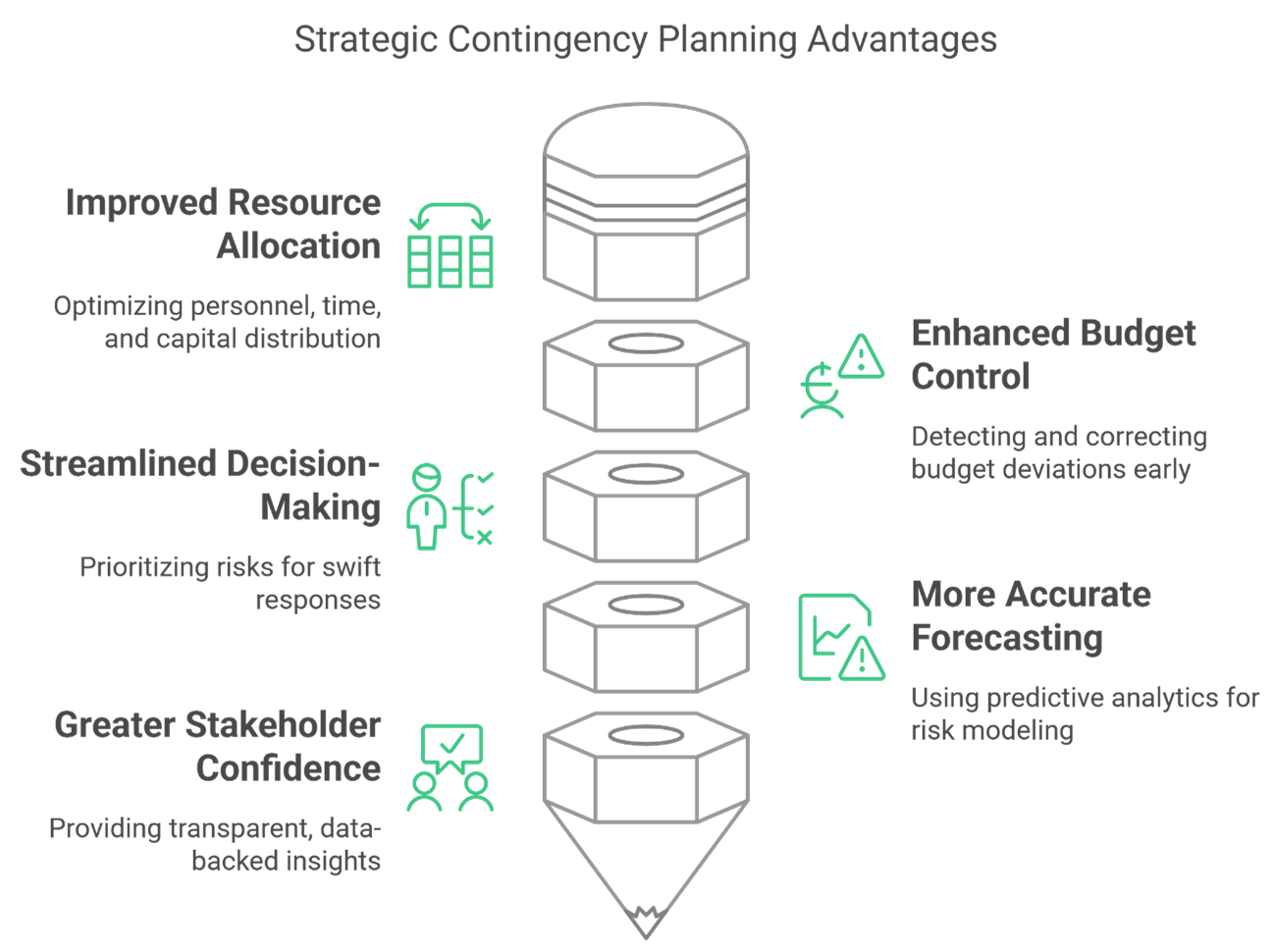
Shifting from a reactive to a proactive contingency planning approach isn't just about improving individual projects; it’s about establishing a sustainable competitive edge.
Get Started Today with TrueProject's Quick-Start Plan: Explore our Quick-Start Plan to immediately implement predictive intelligence into your project processes and experience its impact firsthand.
Practical Steps for Building a Proactive Contingency Plan Framework
Proactive contingency planning requires a deliberate, structured framework integrating predictive capabilities into everyday project activities. Here’s a step-by-step guide to help organizations build a system that doesn’t just react to risks but anticipates and neutralizes them before they escalate:
Step 1: Identify and Prioritize Key Risks
Start by conducting a comprehensive risk assessment to identify potential threats across critical dimensions—budget, schedule, resources, and quality. Assign risk scores based on potential impact and likelihood to ensure teams stay focused on the most important risks.
Step 2: Establish Real-Time Monitoring Systems
Set up systems that continuously monitor live project performance metrics. These systems should automatically flag deviations from expected performance, such as cost overruns or task delays, triggering immediate review and action.
Step 3: Develop Scenario-Based Action Plans
Develop scenario-based action plans by modelling different risk events—such as supply chain disruptions or workforce shortages—and outlining the exact steps teams should take in response.
Step 4: Implement Automated Risk Alerts and Insights
Equip your teams with systems automatically sending real-time alerts when performance indicators deviate from acceptable thresholds. The most effective tools also provide AI-driven recommendations.
Step 5: Foster Cross-Functional Collaboration
Create shared dashboards that provide accessible, real-time risk insights to all relevant parties. This ensures that everyone stays aligned and can collaborate effectively when contingency actions are needed.
Step 6: Conduct Regular Contingency Plan Reviews
Schedule periodic reviews to update risk assumptions, recalibrate predictive models, and adjust action plans based on lessons learned from past projects.
By following these steps, organizations can build a contingency planning framework that is agile, predictive, and highly responsive to project dynamics.
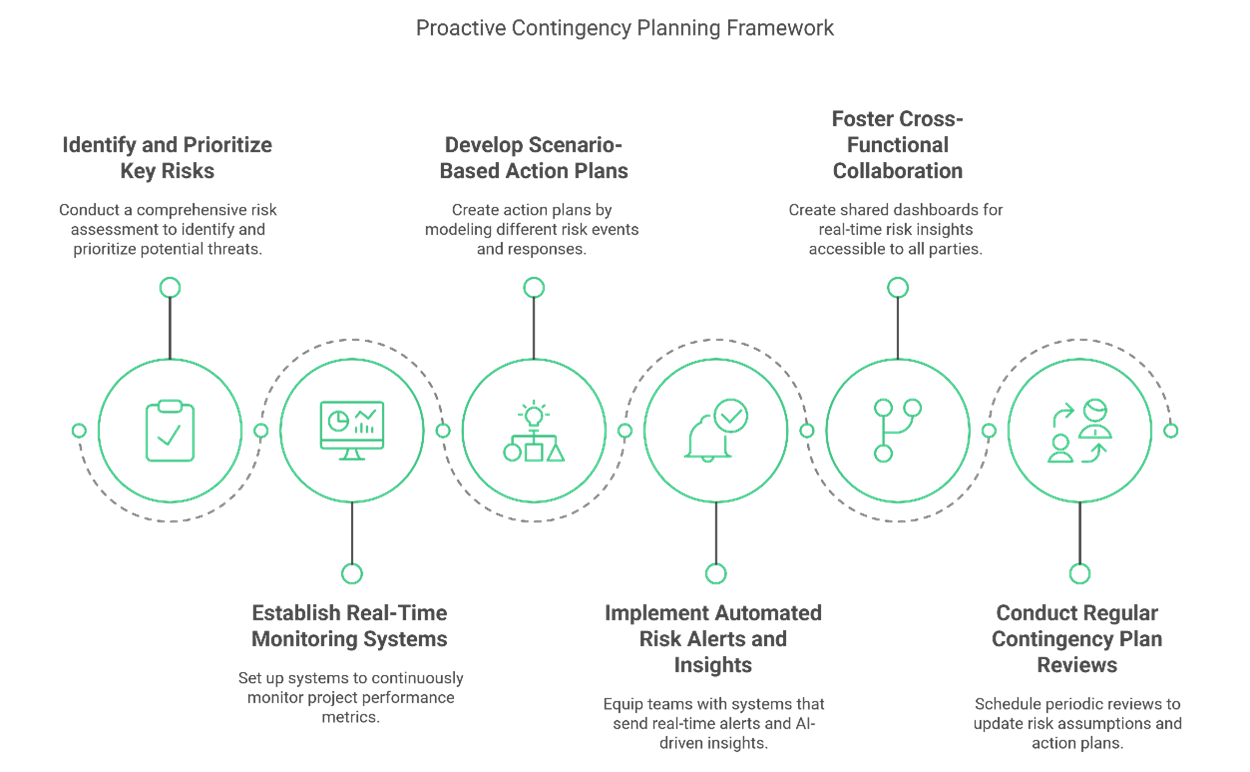
Conclusion: Why TrueProject Is Your Partner in Proactive Contingency Planning
Contingency planning is only as strong as the insights guiding it. Without real-time foresight, even the most detailed plans crumble under shifting project conditions. Advanced predictive intelligence changes this dynamic—turning static assumptions into live, actionable insights that help teams stay ahead of risks, not chase them.
TrueProject bridges this gap with unparalleled precision. As a KPI-based predictive project management SaaS solution, it continuously monitors project performance across critical dimensions—budget, timelines, resources, and risks—detecting early warning signs that conventional tools overlook. Its advanced analytics don’t just identify potential threats; they quantify their impact and provide data-backed recommendations for timely, effective action.
With TrueProject, contingency planning becomes more than a risk management exercise—it becomes a proactive driver of project success. Its collaborative dashboards align stakeholders with a shared, real-time view of potential disruptions, ensuring decisions are swift, strategic, and supported by facts, not guesswork. TrueProject’s scenario-based modeling further empowers teams to simulate various outcomes, preparing them to respond decisively when uncertainties surface.
When the next challenge arises will your contingency plan be prepared or reactive? Equip your teams with predictive intelligence that makes the difference.
Request a demo and experience how TrueProject turns uncertainty into opportunity.






